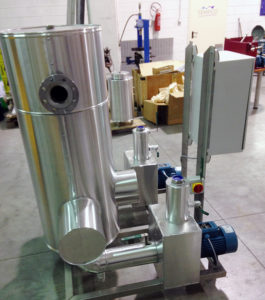

Plants installed on food production processes or in the chemical and pharmaceutical sectors need nearly always temperature regulation systems. One of the peculiarities of these kind of installation is the hygienic and cleaning standards of the production environment required, as it is easy to imagine, and in addition the possibility to easily clean and sanitize equipments serving the production lines. Let’s think for instance of pasteurizers employed for the production of food products, such as milk, creams, eggs or beverages. These are equipments with full-stainless steel construction, offering particular hygienic and sanitary features.
Hence, also machinery serving heating/cooling utilities, if installed within the production area and not in a technical room, require a special engineering and construction. Thermoregulating units aimed to serve chemical and pharma productions, and/or food and beverage processes, have to implement these characteristics:
These requirements entail additional costs, due to the fact that noble materials have to be employed. These are anyway mandatory to safeguard the final products and the production process behind it. In addition, in case of employ with particularly aggressive fluids, due to the frequent washing cycles that equipments are subject to, there are many executions using dedicated materials.
In case of heat exchangers employed in chemical, pharma and food applications, another risk to be absolutely avoided is the mixing between the products and the cooling or heating fluids. For example, think about beverages or drugs to be injected. In heat exchangers, the mixing of fluids can happen only in case of breakage or cracks of thermal transfer surfaces, plates or tubes. There are different reasons that can lead to that:
The breakage of a gasket won’t instead lead to a risk of mixing between the fluids. Indeed, in case of a plate heat exchanger, for example, the breakage of a peripheral gasket generates a leakage toward the outside of the exchanger. In case of breakage of a gasket near the nozzles area, here the gasket is doubled (redundant) with drainage channels toward the outside, preventing mixing and signaling that there is a failure of the exchanger.
The solution available to prevent the mixing of the fluids, in case of breakage of a plate or tube, is the double wall execution, that guarantees that fluids can never mix inside the heat exchanger. This is quite an expensive solution, both in terms of costs and energy consumption: it involves indeed the presence of a double wall, which means doubled plates in case of plate heat exchangers or tubes in case of tube exchangers. It is then easy to argue that the higher construction costs – due to the higher amount of construction materials employed ad the more sophisticated design – are also combined with a lower thermal transfer efficiency. The decreased thermal exchange rate has then to be compensated by increasing the overall thermal transfer surface area.
Specific applications that can be deployed in this peculiar sector are then virtually numberless. Let’s just make a couple of examples.
The first one is the cooling of salt solutions employed to cool food products after the pasteurization step, such as sausages. Salt solutions employed in food production can be cooled using a falling film cooler. This is a special deployment of TCOIL dimple jacket exchangers, in which a direct expansion refrigerating gas or a refrigerated fluid flows. The falling film cooler solution ensures easy cleaning operations, maximum accessibility and efficiency. In this kind of application the cooling solution enters in direct contact with the product, draining fat particles and other contaminating substances, which would clog a traditional heat exchanger in a very short time, thus engendering complicated cleaning and sanitizing operations.

In the chemical and pharma sector is instead essential to think that reactions that happen during the mixing of different substances, aimed to obtain active pharmaceutical ingredients or other sub products, generate energy. Some chemical reactions involve the generation or the absorption of heat, and that’s what respectively happens:
There are several different type of reactions that are possible, such as exchange, synthesis, decomposition and combustion. All of these reactions happen in equipments called reactors, usually under pressure devices with mixers inside them, and an external jacket or a half-tube aimed for temperature regulation, which in most modern plants is achieved using mono fluid thermoregulation systems. These are thermoregulating units complete with a pumping system, and equipped with heat exchangers sized depending on the temperature levels required to achieve the different reactions. A related control system with automated valves, that can be managed both locally and remotely, allow to supply the reactor with a circulating fluid at different temperatures.